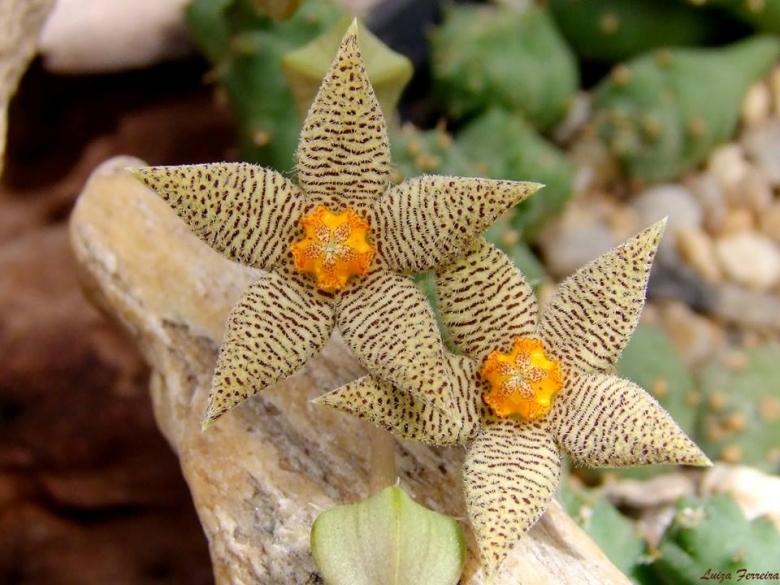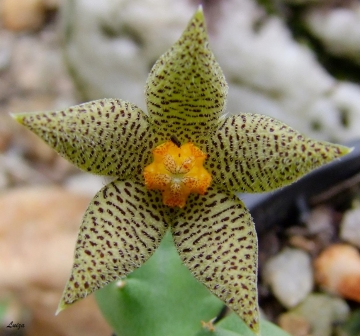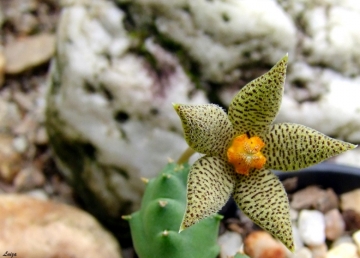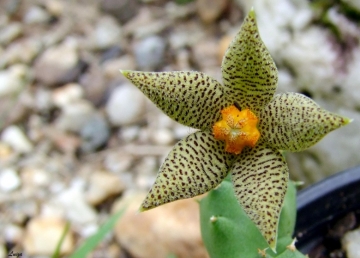Accepted Scientific Name: Piaranthus geminatus subs. decorus (Masson) Bruyns
Stapeliads S. Africa Madagascar 2: 361. 2005 Bruyns

Orbea decora (Piaranthus geminatus subs. decorus) Photo by: Luiza Ferreira
Origin and Habitat: Republic of South Africa (Northern Cape, Western Cape)
Altitude range: Western Mountain Karoo to 1300 metres above sea level.
Synonyms:
See all synonyms of Piaranthus geminatus
Description: Piaranthus decorusSN|18048]]SN|18048]] is a clumping and prostrate species that spread over the ground forming large cushions of jointed brownish-green stems. The starfish-like flowers form in small bunches at the tips of the young stems, cream-yellow or green-yellow with bright to dark red-brown or brown dots, patches or transverse bands and densely velvety-hairy.
Stems: Decumbent, 1.5-5 cm long, or under cultivation sometimes very much longer, 12-20 mm thick, obscurely or very obtusely 4-angled, oblong, with 3–5 small tubercle-like teeth along each angle, glabrous, greyish-green, or under cultivation green, slightly glaucous.
Flowers: In pairs above the middle of the stems, erect with sweetish odour of decaying fruits. Pedicels 5-20 mm long. Sepals about 3 mm long, 1-1.5 mm wide, ovate-lanceolate, acute or acuminate, glabrous;. Corolla 1.5-3 cm in diameter, rotate, without a distinct tube, lobed to 3/4 of the way down. Corolla-lobes 10-12 mm long, 4-5 mm broad at the base, usually horizontally expanded, lanceolate, acute, apically often recurved, glabrous on the back, cream-yellow or green-yellow with bright to dark red-brown or brown dots, patches or transverse bands on the inner face, densely velvety-hairy not ciliate, hairs 0.1 - 0.5 mm, conical, white to bright purple ivory-coloured. Corona about 2.5 - 3 (-3.5) x 4.2 - 5 mm. Inner corona-lobes about 1.2-2 mm long, 0.5 - 1 mm thick, closely incumbent upon the backs of the anthers and shorter than or slightly exceeding them, lanceolate or ovate, varying (even in the same flower) from acute to irregularly toothed at the apex, dorsally produced at the base into a short transversely rectangular crest, truncate or irregularly toothed at the rather acute-edged dorsal margin, with slight ridges from the edge to the inflexed part of the lobe, yellow, not spotted. Pollinia 0.5 - 0.6 x 0.3 – 0.35 mm.
Fruit (follicles): The fruit are paired spindle-shaped capsules about 8 cm long and 0.5 cm across, resembling the horns of an antelope, with the tightly packed seeds inside. At maturity they split open to release numerous small brown seeds crowned with long white hairs.
Seeds: About 4.5 x 2.5 mm.
Note: In this species most of the corona-lobes are entire at the apex, but some of them are toothed, as represented in Jacquin's figure of Stapelia serrulataSN|18055]]SN|18055]], but that plant and Piarantus decorus, Masson, are one species (N. E. Brown 1909).
Subspecies, varieties, forms and cultivars of plants belonging to the Piaranthus geminatus group
 Piaranthus barrydalensis Meve: flowers whitish to yellowish with brown-red dots or transverse lines margin recurved. Corona yellow, and red. Distribution: Barrydale in the Little Karoo
Piaranthus barrydalensis Meve: flowers whitish to yellowish with brown-red dots or transverse lines margin recurved. Corona yellow, and red. Distribution: Barrydale in the Little Karoo Piaranthus disparilis N.E.Br.: has smaller corolla-lobes and different markings on the corolla. The crest of the corona-lobes is distinctly toothed, not merely minutely tuberculate. Distribution: Cape Province (Central region Laingsburg Div.)
Piaranthus disparilis N.E.Br.: has smaller corolla-lobes and different markings on the corolla. The crest of the corona-lobes is distinctly toothed, not merely minutely tuberculate. Distribution: Cape Province (Central region Laingsburg Div.)  Piaranthus geminatus (Masson) N.E.Br.: Flowers 13-42 mm in diameter, star-shaped, more or less pubescent, whitish, yellowish, reddish or bright brown, with or without brown-red dots or transverse lines. Corona yellow, unspotted.
Piaranthus geminatus (Masson) N.E.Br.: Flowers 13-42 mm in diameter, star-shaped, more or less pubescent, whitish, yellowish, reddish or bright brown, with or without brown-red dots or transverse lines. Corona yellow, unspotted.  Piaranthus geminatus subs. decorus (Masson) Bruyns: flowers green-yellow with dark red-brown, patches or bands and densely velvety-hairy. inner corona lobes incumbent on the anthers with large and deeply furrowed crests. Distribution: Northern Cape, Western Cape.
Piaranthus geminatus subs. decorus (Masson) Bruyns: flowers green-yellow with dark red-brown, patches or bands and densely velvety-hairy. inner corona lobes incumbent on the anthers with large and deeply furrowed crests. Distribution: Northern Cape, Western Cape. Piaranthus geminatus var. foetidus (N.E.Br.) Meve: Flowers 18 mm to 30 mm in diameter, star-shaped, pubescent, and velvety ivory, to sand coloured, with brown-red dots or transverse lines. Corona yellow to orange.
Piaranthus geminatus var. foetidus (N.E.Br.) Meve: Flowers 18 mm to 30 mm in diameter, star-shaped, pubescent, and velvety ivory, to sand coloured, with brown-red dots or transverse lines. Corona yellow to orange. Piaranthus globosus A.C.White & B.Sloane: The name is due to the stem segments that are ovoid or globose, light green and resemble a mass of tiny potatoes.
Piaranthus globosus A.C.White & B.Sloane: The name is due to the stem segments that are ovoid or globose, light green and resemble a mass of tiny potatoes. Piaranthus pillansii N.E.Br.: flowers 3-4 cm wide, typically greenish yellow, pale yellow or very pale-reddish, without (or with very fine) red spots. Corona yellowish-green.
Piaranthus pillansii N.E.Br.: flowers 3-4 cm wide, typically greenish yellow, pale yellow or very pale-reddish, without (or with very fine) red spots. Corona yellowish-green.- Piaranthus pillansii var. fuscatus N.E.Br.: lobes broad, lanceolate, acuminate, dark purple (or dark crimson?) with very numerous slender irregular transverse and labyrinthine greenish-yellow lines and markings.
- Piaranthus pillansii var. incostans N.E.Br.: lobes densely dotted or transversely marked with light purple on an ochreous ground, sometimes so minutely as to look light pinkish-brown.
Bibliography: Major references and further lectures
1) N. E. Brown. “Flora Capensis”, Vol 4, 1909
2) 2) Focke Albers, Ulrich Meve “Illustrated Handbook of Succulent Plants: Asclepiadaceae: Asclepiadaceae” Volume 4 Springer Science & Business Media, 2002
3) James Cullen, Sabina G. Knees, H. Suzanne Cubey “The European Garden Flora Flowering Plants: A Manual for the Identification of Plants Cultivated in Europe, Both Out-of-Doors and Under Glass” Cambridge University Press, 11/August/2011
4) Foden, W. & Potter, L. 2005. Piaranthus geminatus (Masson) N.E.Br. subsp. decorus (Masson) Bruyns. National Assessment: Red List of South African Plants version 2014.1. Accessed on 2015/02/15
 Orbea decora (Piaranthus geminatus subs. decorus) Photo by: Luiza Ferreira
Orbea decora (Piaranthus geminatus subs. decorus) Photo by: Luiza Ferreira Orbea decora (Piaranthus geminatus subs. decorus) Photo by: Luiza Ferreira
Orbea decora (Piaranthus geminatus subs. decorus) Photo by: Luiza Ferreira Orbea decora (Piaranthus geminatus subs. decorus) Photo by: Luiza Ferreira
Orbea decora (Piaranthus geminatus subs. decorus) Photo by: Luiza FerreiraSend a photo of this plant.The gallery now contains thousands of pictures, however it is possible to do even more. We are, of course, seeking photos of species not yet shown in the gallery but not only that, we are also looking for better pictures than those already present.
Read More...














